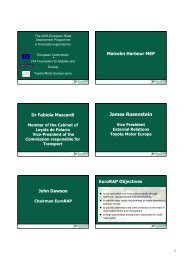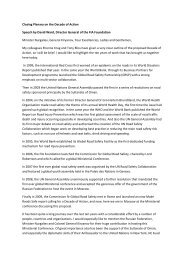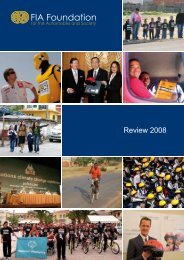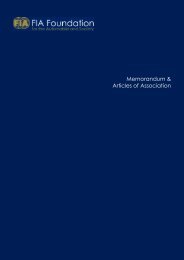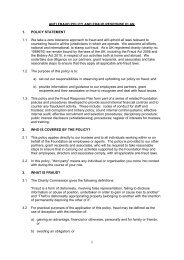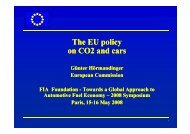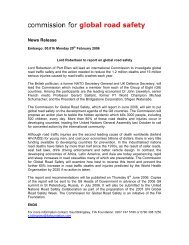Vehicle safety is global - Global NCAP
Vehicle safety is global - Global NCAP
Vehicle safety is global - Global NCAP
Create successful ePaper yourself
Turn your PDF publications into a flip-book with our unique Google optimized e-Paper software.
safercar.gov<br />
NHTSA/U.S. <strong>NCAP</strong><br />
1200 New Jersey Avenue, SE<br />
Washington, DC 20590<br />
USA<br />
T +1 888-327-4236<br />
crash.test@dot.gov<br />
The United States New Car Assessment Program (U.S. <strong>NCAP</strong>) <strong>is</strong> a flagship<br />
consumer information program of the U.S. Department of Transportation’s<br />
National Highway Traffic Safety Admin<strong>is</strong>tration (NHTSA).<br />
NHTSA pursues its m<strong>is</strong>sion of reducing motor vehicle crash-related<br />
deaths and injuries through Federal motor vehicle <strong>safety</strong> standards and<br />
other regulations. It also conducts consumer vehicle <strong>safety</strong> programs,<br />
including U.S. <strong>NCAP</strong>, which educates consumers about vehicle <strong>safety</strong><br />
and encourages manufacturers to produce vehicles that exceed minimum<br />
Federal <strong>safety</strong> requirements.<br />
U.S. <strong>NCAP</strong> began in 1978 with frontal crashworthiness testing and<br />
information, and has grown in scope since then. Today it uses a 5-star<br />
system to rate vehicles for frontal and side crashworthiness and rollover<br />
res<strong>is</strong>tance. The program was enhanced for the 2011 model year. It also<br />
recommends advanced crash avoidance technologies that meet U.S.<br />
<strong>NCAP</strong> criteria. U.S. <strong>NCAP</strong>-driven vehicle <strong>safety</strong> improvements have<br />
helped significantly reduce crash-related deaths and injuries in the U.S.<br />
CURRENT Programs<br />
U.S. <strong>NCAP</strong> provides consumers with a variety of vehicle <strong>safety</strong> ratings<br />
and information via its user-friendly website, www.safercar.gov. A <strong>safety</strong><br />
rating label <strong>is</strong> also required on the window sticker of all new vehicles.<br />
Th<strong>is</strong> gives consumers another source for U.S. <strong>NCAP</strong> ratings and<br />
ensures they have th<strong>is</strong> information at the point of sale. Each vehicle’s<br />
rating and <strong>safety</strong> information has several components:<br />
• In addition to full-frontal crashworthiness testing, U.S. <strong>NCAP</strong><br />
conducts two types of side-impact protection testing: one simulating<br />
a vehicle-to-vehicle coll<strong>is</strong>ion and the other simulating a vehicle-topole<br />
coll<strong>is</strong>ion. The crashworthiness testing incorporates both 50th<br />
percentile male and 5th percentile female dummies, and ratings are<br />
based on a wide range of injury criteria.<br />
• Rollover res<strong>is</strong>tance ratings are based on a vehicle’s static properties,<br />
along with a dynamic test.<br />
• An overall vehicle score combines the results of three crashworthiness<br />
tests and the rollover res<strong>is</strong>tance test into a single star rating for<br />
simple consumer compar<strong>is</strong>on.<br />
• As part of a new focus on crash avoidance technologies, U.S. <strong>NCAP</strong><br />
recommends electronic stability control, lane departure warning, and<br />
forward coll<strong>is</strong>ion warning systems that meet U.S. <strong>NCAP</strong> criteria.<br />
Separately, U.S. <strong>NCAP</strong> provides child restraint usability ratings to help<br />
consumers make informed purchasing dec<strong>is</strong>ions.<br />
fUTURE Plans<br />
Two areas will drive future U.S. <strong>NCAP</strong> enhancements:<br />
• Improvements in the <strong>safety</strong> performance of the U.S. vehicle fleet.<br />
When appropriate, U.S. <strong>NCAP</strong> will adjust its rating system to reflect<br />
improvements in the <strong>safety</strong> performance of the U.S. vehicle fleet,<br />
making it more difficult for a vehicle to achieve top ratings.<br />
• Analys<strong>is</strong> of real-world crash data to identify possible additional<br />
crash modes and additional advanced technologies to include in<br />
U.S. <strong>NCAP</strong>. Crash types other than frontal, side, and rollover crashes<br />
could be addressed. Also, as more advanced technologies are<br />
introduced in new vehicles, U.S. <strong>NCAP</strong> may consider new testing<br />
protocols for their evaluation.



